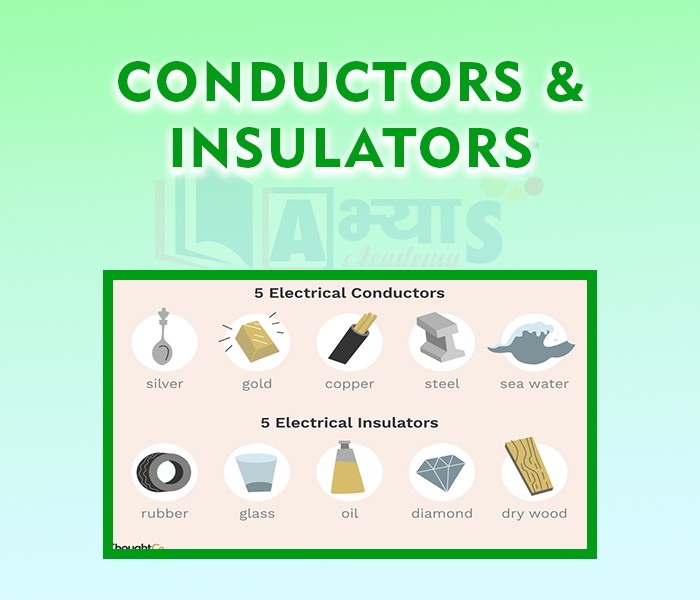Conductors and Insulators












Conductors and Insulators
Conductors :
Conductors are materials or substances which allow electricity to flow through them. They conduct electricity because that have free electrons which can flow easily inside them from atom to atom. Also conductors allow the transmission of heat or light from one source to another.
Metals, humans, earth, animals are all conductors. The human body is a good conductor. So it provides a resistance- free path for the current to flow from wire to body. This is the reason we get electric shocks.
Conductors have free or valence electrons which allow current to pass through it easily.
Examples of conductors :
Insulators :
These are the materials or substances which do not allow electricity to pass through them. This happens because they do not have free electrons to flow form one atom to other. These materials also do not allow the conduction of heat or light through them.
Plastic, glass, wood are some of the examples of insulators. This is the reason why electric wires are coated with plastic coating. PVC coating do not allow the electric current to leak to the surroundings.
Examples :
|
S.No 1. 2 3 4 5 6 |
Conductors Silver Copper Aluminum Lead Tap water Gold |
Insulators Plastic Glass Bakelite Cotton Wood Cork |
S.No. 7 8 9 10 11 12 |
Conductors Human body Living plant Brass Tin Iron steel |
Insulators Silk Pure water Rubber Leather Ebonite Nylon |
Both conductors and insulators are important in using electricity. Whenever we want to make a circuit to use electric current in some way, for example, to light a bulb, run a fan, work an oven or run a washing machine,we use wires made of a metal, such as copper or aluminium, which are good conductors. However, we cannot use bare wires as this would be dangerous. A bare wire carrying current can give you an electric shock. Therefore, wires are always coated with an insulating material, such as plastic. You would also have noticed that the outer coverings of switches, regulators of fans, plugs, sockets, etc. are made of an insulating material, such as plastic or bakelite. This saves you from getting electric shocks.
Conductors have __________ | |||
| Right Option : A | |||
| View Explanation | |||
Materials which allow larger currents to flow through them are called ________________ | |||
| Right Option : B | |||
| View Explanation | |||
Gases are good conductors of electricity at ____________________ | |||
| Right Option : B | |||
| View Explanation | |||
Students / Parents Reviews [10]
I have spent a wonderful time in Abhyas academy. It has made my reasoning more apt, English more stronger and Maths an interesting subject for me. It has given me a habbit of self studying

Yatharthi Sharma
10thOne of the best institutes to develope a child interest in studies.Provides SST and English knowledge also unlike other institutes. Teachers are co operative and friendly online tests andPPT develope practical knowledge also.

Aman Kumar Shrivastava
10thIt was good as the experience because as we had come here we had been improved in a such envirnment created here.Extra is taught which is beneficial for future.

Eshan Arora
8thIt was a good experience with Abhyas Academy. I even faced problems in starting but slowly and steadily overcomed. Especially reasoning classes helped me a lot.

Cheshta
10thMy experience was very good with Abhyas academy. I am studying here from 6th class and I am satisfied by its results in my life. I improved a lot here ahead of school syllabus.

Ayan Ghosh
8thBeing a parent, I saw my daughter improvement in her studies by seeing a good result in all day to day compititive exam TMO, NSO, IEO etc and as well as studies. I have got a fruitful result from my daughter.

Prisha Gupta
8thIt has a great methodology. Students here can get analysis to their test quickly.We can learn easily through PPTs and the testing methods are good. We know that where we have to practice

Barkha Arora
10thAbout Abhyas metholodology the teachers are very nice and hardworking toward students.The Centre Head Mrs Anu Sethi is also a brilliant teacher.Abhyas has taught me how to overcome problems and has always taken my doubts and suppoeted me.

Shreya Shrivastava
8thMy experience with Abhyas academy is very good. I did not think that my every subject coming here will be so strong. The main thing is that the online tests had made me learn here more things.

Hiya Gupta
8thAbhyas is a complete education Institute. Here extreme care is taken by teacher with the help of regular exam. Extra classes also conducted by the institute, if the student is weak.
